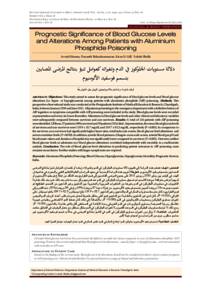Document
Prognostic significance of blood glucose levels and alterations among patients with aluminum phosphide poisoning.
Identifier
doi: 10.18295/squmj.2018.18.03.006
Contributors
Other titles
دلالة مستويات الجلوكوز في الدم وتغيراته كعوامل تنبؤ بنتائج المرضى المصابين بتسمم فوسفيد الألومنيوم
Publisher
College of Medicine, Sultan Qaboos University.
Gregorian
2018-06
Language
English
Subject
English abstract
Objectives: This study aimed to assess the prognostic significance of blood glucose levels and blood glucose
alterations (i.e. hyper- or hypoglycaemia) among patients with aluminium phosphide (AlP) poisoning. Methods: This
prospective observational study was conducted at the Postgraduate Institute of Medical Education & Research, Chandigarh,
India, between January 2010 and June 2011. All patients presenting to the emergency department with a definitive history of
AlP ingestion or symptoms compatible with AlP poisoning were included in the study. Blood glucose levels were recorded
at presentation and every six hours thereafter. Alterations in blood glucose levels and other clinical and laboratory variables
were subsequently compared between survivors and non-survivors. Results: A total of 116 patients with AlP poisoning
were identified. Of these, 57 patients (49%) survived and 59 patients (51%) died. At presentation, the mean blood glucose levels
of survivors and non-survivors were 119.9 ± 35.7 mg/dL and 159.7 ± 92.5 mg/dL, respectively (P <0.001). In comparison to
the survivors, non-survivors had significantly higher heart rates, total leukocyte counts, blood glucose level alterations and
serum creatinine levels (P <0.050). In addition, systolic blood pressure, Glasgow coma scale scores, arterial blood gas pH and
bicarbonate values and duration of hospital stay was significantly lower compared to survivors (P <0.001). However, neither
blood glucose levels at admission nor blood glucose alterations correlated independently with mortality in a multivariate
analysis. Conclusion: The role of blood glucose level alterations in predicting patient outcomes in AlP poisoning cases
remains inconclusive. Further studies with larger sample sizes are required
Member of
Resource URL
Arabic abstract
الهدف: هدفت هذه الدراسة إلى تقييم دلالة مستويات الجلوكوز في الدم وتغيراته (زياده أو نقصان) كعوامل تنبؤ بنتائج المرضى المصابين بتسمم فوسفيد الألومنيوم. الطريقة: أجريت هذه الدراسة الرصدية في معهد الدراسات العليا للتعليم الطبي والبحوث في شانديغار، الهند، في الوقت بين يناير 2010 و يونيو 2011 على جميع المرضى القادمين إلى قسم الطوارئ بعد التأكد من ابتلاع فوسفيد الألومنيوم أو أعراض متوافقة مع هذا التسمم. تم تسجيل مستويات الجلوكوز في الدم عند قدومهم وكل ست ساعات بعد ذلك. تمت بعد ذلك مقارنة التغييرات في مستويات الجلوكوز في الدم وغيرها من المتغيرات السريرية والمخبرية بين الناجين وغير الناجين من التسمم. النتائج: تم تحديد مجموعه 116 مريضا أصيبو بتسمم فوسفيد الألومنيوم. من هؤلاء، نجا 57 مريضا (%49) وتوفي 59 مريضا (%51)، عند القدوم إلى قسم الطواريء، كان متوسط مستويات السكر في الدم للناجين وغير الناجين 35.7 + 119.9 ملغ/ديسيلتر و 92.5 ± 159.7 ملغم/ديسيلتر ، على التوالي (0.001>P ) كان لدى غير الناجين بالمقارنة مع الناجين قيم أعلى بشكل ملحوظ لمعدل ضربات قلب، أعداد كريات الدم البيض، تغيرات مستوى الجلوكوز ومستويات الكرياتينين في الدم (0.050>P ) بالإضافة إلى ذلك، كان ضغط الدم الانقباضي ومقياس غيبوبة غلاسكو ودرجة الحموضة ومستوى البيكربونات في الدم الشرياني ومدة الإقامة في المستشفى أقل بكثير مقارنة بالناجين (0.001>P ) ومع ذلك، لا ترتبط مستويات الجلوكوز في الدم عند القدوم ولا تغيرات الجلوكوز في الدم بشكل مستقل مع معدل الوفيات في التحليل متعدد المتغيرات. الخلاصة: لا يزال دور تغيرات مستوى الجلوكوز في الدم في التنبؤ بنتائج المرضى في حالات تسمم فوسفيد الألومنيوم غير حاسم. مطلوب مزيد من الدراسات مع أحجام عينة أكبر
Category
Journal articles

